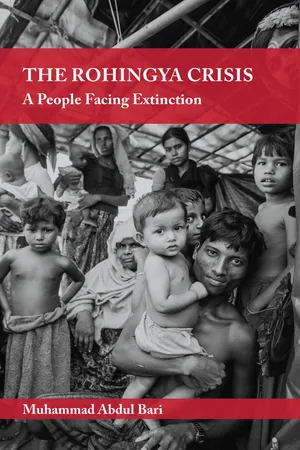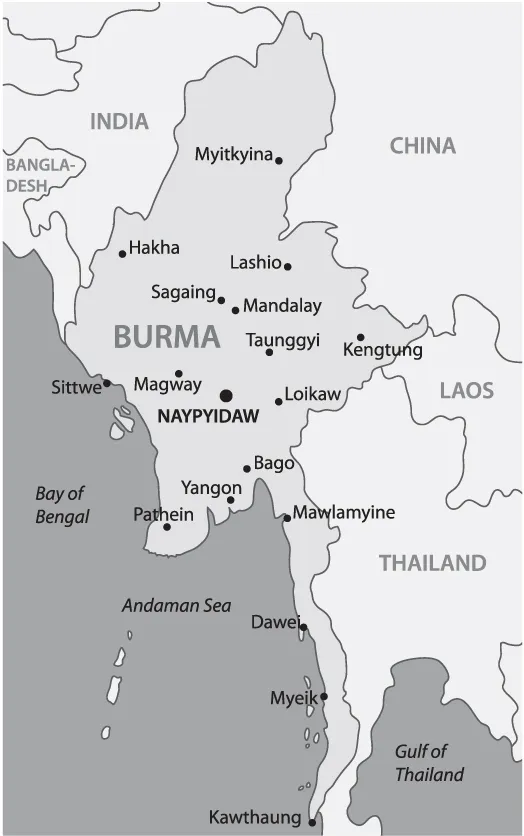![]()
1
Origins of the Arakanese Muslims1
Myanmar, Bangladesh and the Indian Ocean
Arakan2 is a coastal region of the south Asian subcontinent, with the Bay of Bengal to its west, Bangladesh and India to its north and Burma proper (isolated by the Arakan Mountains, also called Arakan Yoma) to its east. It is a long narrow strip of land along the eastern seaboard of the Bay of Bengal. Arakan stretches from the Naf River estuary on the border of Bangladesh’s Chittagong district. It is about 400 miles long from north to south and about 90 miles wide at its broadest. The Arakan coast has several sizable offshore islands and one-tenth of Arakan’s generally hilly land is cultivable.
In order to deny the Rohingya their rights and citizenship, Burmese administrations have been trying to prove they were immigrants brought by the British colonial rule in the nineteenth and twentieth centuries. But history has established that in fact Muslims arrived in what was then the independent kingdom of Arakan (now Rakhine) as long ago as in the eighth century,3 around the time when the Vikings first visited Britain in 789 CE. They were originally seafarers and traders from the Middle East, and renowned Bangladeshi historian Dr Abdul Karim suggests there were four phases of Muslim presence in Burma.
The first phase
As far back as the early period of Islam, highly-spirited Arab traders were exploring the world, with trading activities from the Red Sea to far flung areas such as the Chinese coast and Arakan within Burma (now the state of Myanmar). It is difficult to ascertain exactly when Arabs arrived at Arakan, but they established contact during eighth to tenth centuries. Some came to Chittagong in Bengal and others to the Ayeyarwady (or Irrawaddy) River Delta in Arakan. Maungdaw, in northern Arakan, became one of their favourite destinations. All this happened prior to the establishment of the first Burmese empire in 1055 CE by the pagan King Anawrahta Minsaw.4
During the reign of the Burmese king Mahato Tsandaya (788–810 CE) several Arab ships were wrecked off the coast of the Rambi Islands and sailors were rescued from the shore. They were taken to the king who allotted a piece of land for them, where they were allowed to settle. As a trading people, these early Arab settlers were inspired by Islam’s message of universalism; some indigenous people might have accepted Islam in this early period.
The second phase
In the early fifteenth century there were huge political upheavals in Arakan. The Arakanese king, Min Saw-Mun, was defeated by the Burmese King in 1406 CE and expelled from his kingdom; he took refuge in Bengal which was then ruled by Ghiyasuddin Azam Shah. But Bengal itself witnessed several palace intrigues, groups and fighting at that time. Eventually, Min Saw-Mun regained his territory with the help of Jalal-ud-din Mohamed Shah, the Sultan of Bengal, and returned to the kingdom after about a quarter of a century. His stay in Bengal gave him a great deal of knowledge about Bengali, Arabic and Persian languages and literature. During his reinstatement, a large contingent of Muslims from Bengal (several thousand) entered Arakan in 1430 CE. They were mainly soldiers and administrators who were needed to help the reinstated king regain his throne, but many of them stayed behind after their mission was complete. Min Saw-Mun naturally made some agreements with his benefactor, the Sultan of Bengal, before he was restored; one was bearing the cost of the expedition. He used Muslim titles with the court emblem inscribed with the Islamic Kalimah (declaration of faith) and used Persian as the court language. He transferred the Arakan capital from Launggyet to the city of Mrauk-U, near the eastern coast of the Bay of Bengal, which became a vibrant city with a diverse range of people establishing mosques, temples, shrines, seminaries and libraries.
In effect, from 1430 to 1531 Arakan remained a protectorate of the Bengal Sultanate. According to historians, Arakan kings were Buddhists and there is no proof that any of them accepted Islam, but their voluntary practice of adopting Muslim names continued for more than two hundred years. Min Saw-Mun himself adopted the name of Sulaiman Shah or Sawmun Shah and ruled Arakan until his death in 1434 CE. Historians have argued as to why Arakanese kings, especially in the sixteenth and seventeenth centuries, adopted Muslim names even though they were Buddhists and independent rulers. The likely explanation is Muslims were probably seen as culturally more sophisticated during that period.
During the fifteenth and sixteenth centuries, various specialists and professional people, as well as some prominent individuals including renowned Bengali Muslim poets, came to Arakan. Some of them settled in the capital Mrauk-U, often known as Mrohaung or Roshang. This further enlivened the capital city with religious, social and cultural activities. Arab traders also frequented Arakan until the sixteenth century.
In the seventeenth century, some renowned Bengali Muslim poets wrote of their impression that the capital city of Roshang (Mrohaung or Mrauk-U) thronged with Muslims in the courts as well as in religious, social and cultural assemblies. Then there were Muslim artisans, craftsmen and traders, as well as men connected with the mint and other state establishments.
The third phase
This phase began with the arrival of the Europeans in the seventeenth century, with their superior vessels and better merchandise; at that time, the Arabs began to lose their edge in the eastern trade. This group of settlers included both Muslims and Hindus, who were kidnapped from the coastal areas of Bengal by Portuguese pirates5 and Arakanese Maghs6 and sold to slavery. The Portuguese pirates had a particular racial hatred and religious aversion to Moors,7 and by extension any Muslim, probably because they were ruled by Arabs some centuries earlier. During this period, the Arakanese Magh kings employed the Portuguese to loot and plunder the coastal districts of Bengal; the Maghs joined them in these criminal attacks. These raids became widespread and continued for a long time. Ordinary people in the coastal Bengal areas used to live in fear, and the term Moger Mulluk, meaning an anarchic state, has since been used in the Bengali language because of the dreaded piracy of that period. I came across this term from the elders in my childhood.
Some of the slaves captured by the Portuguese pirates were sold to priests who converted them to Christianity. The Maghs mostly used their captives for manual labour, such as tilling the soil, cutting trees and felling. Thousands of Bengali captives (Muslims and Hindus) were made to settle in Arakan, thus increasing the Muslim and Indian population there. Some of them were released when the Mughals took over Chittagong.
The fourth phase
This began in the middle of the seventeenth century, when power politics at the heart of the Mughal Empire in India forced one of Aurangzeb’s brothers, Shah Shuja, to take shelter in Arakan. In addition to his family, there were around 1,000 Muslims in his entourage. The Arakanese king gave them asylum, but once he proposed to marry a daughter of Shah Shuja, the relationship between them turned sour. Ultimately, Shah Shuja was murdered with his family by order of the king. However, those in Shah Shuja’s entourage stayed behind and along with the existing Muslims contributed towards building a pluralist Arakan.
1 Abdul Karim, The Rohingyas: a short account of their history and culture (Chittagong: Arakan Historical Society, 1997).
2 The Editors, ‘Arakan State, Myanmar’ (Encyclopædia Britannica, 20 July 2002). Available at: https://www.britannica.com/place/Arakan (accessed on 31 January 2018).
3 ‘The Rohingyas’ (The Economist, 13 June 2015).
4 The Editors, ‘Anawrahta, King of Myanmar’ (Encyclopædia Britannica, 20 July 1998). Available at: https://www.britannica.com/biography/Anawrahta (accessed on 31 January 2018).
5 When the Bengali Sultanate became weakened in the sixteenth and seventeenth centuries, Portuguese-Arakanese piracy increased against Mughal Bengal and ravaged the Arakan coast.
6 The term is used for the Arakanese or Rakhine people. They joined hands with Portuguese pirates and were involved in the slave business in the seventeenth century.
7 The term refers primarily to Muslims of North Africa, the Iberian Peninsula, Sicily, and Malta during the Middle Ages. It also refers to Arabs.
![]()
2
Arakan’s Thriving Legacy
The Rohingya Muslim legacy in Arakan is rich. This is their ancestral homeland, where Muslim rule and influence lasted for centuries, particularly during the glorious period of Mrauk-U from early 1430 to 1784 that saw a thriving age of power and prosperity with multi-ethnic and multi-religious people living together in relative peace and harmony. With a hybrid Buddhist-Islamic court, it successfully fused traditions from Persia and India with the Buddhist world in the east. There were opportunities for all: Muslim Qazi courts were set up throughout the kingdom; Persian and Bengali languages were not only patronised but used as the court languages; coins and medallions inscribed with the Muslim Kalimah (declaration of faith) in Persian and Arabic script were often minted; Muslim trade and business also flourished, as they were also the main providers of agriculture.
The Arakanese poet, Syed Alaol1 (1607–73), was the most prominent of all poets in Roshang. Born in the Faridpur district, he was the son of a Bengali Minister, but he ended up in Arakan as a captive of Portuguese pirates while travelling by boat with his father. His father died a martyr, but Syed Alaol was sold in Arakan and appointed a horseman in the Arakan army. Alaol was a learned man with a literary knowledge of Bengali, Arabic, Persian and Sanskrit languages. He had a natural disposition to poetry, and as his reputation as a scholar and poet spread, high-ranking officials, including Prime Minister Magan Thakur, patronised him in many ways. Alaol wrote a number of famous books and is considered to be one of the most prolific medieval Bengali Arakan poets. His most well-known work is Padmavati, which depicted the story of Padmavati (a Sinhalese princess) and the queen of Chittor (a city in Rajasthan, India). He wrote on the unique nature of human diversity in the then Arakan and his poems drew upon his deep spirituality. Since most of his poems combined emotion with intellect, he has been called the Pandit Kobi (Wise Poet) of medieval Bengali literature.
While writing on the Rohingya history of Arakan, Dr Abdul Karim also mentions the immense Muslim contribution and their huge influence in politics, culture, literature and other walks of life during the sixteenth and seventeenth centuries. Sadly space means that I can only offer a glimpse of this here.
Historical evidence shows that there were at least three Prime Ministers (Magan Thakur, Sayyid Musa and Nabaraj Majlis), three Defence Ministers (Burhanuddin, Ashraf Khan and Bara Thakur) and two Ministers (Sayyid Muhammad and Srimanta Sulaiman) who were Muslims2 and contributed greatly to Arakan’s rich history. In addition, many Muslims were appointed as Judges (called qazi or qadi in Arabic) following the examples of the Bengal Sultanate. One of the judges, Daulat Qazi, was also a renowned poet and Sufi; he was born in Bengal’s Chittagong district and started writing a book at the request of Defence Minister Ashraf Khan, who himself was of Sufi inclination. Daulat Qazi3 died before he could finish his work and it was later completed by Alaol. There were fam...

